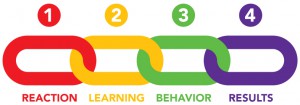10 May
2017
EVALUATING LONG-TERM TRAINING EFFECTIVENESS
By Michelle McLain
At some point in our careers, most of us have participated in a professional development training program. Your courses may have been face-to-face instructor-led, virtual instructor-led, web-based training or a blended training program. Whatever the format, it’s very likely you completed one of the several types of evaluations based on the Kirkpatrick Evaluation Model.
Kirkpatrick Model Level 1: Reaction evaluations provide high-level feedback on training, including opinions and reactions to course content, instructional strategies and course materials. Level 2: Learning evaluations test knowledge before, during and immediately after training in the form of knowledge checks and pre- and post-assessments. You have probably experienced these during your career, but have you ever participated in Level 3 or 4 evaluations? Level 3 and 4 evaluations, while not necessary for every training program or course, provide evidence of effectiveness and business value by measuring long-term, on-the-job behaviors and business results.
 Level 3: Behavior evaluations are typically completed one to three months after training has taken place and provide evidence of an employee applying the new knowledge and skills to their work. Level 3 evaluations, for example, could measure an employee’s time to task completion or accuracy. Evaluation methodologies may include conducting observations, one-on-one interviews and focus groups, and distributing questionnaires or surveys.
Level 3: Behavior evaluations are typically completed one to three months after training has taken place and provide evidence of an employee applying the new knowledge and skills to their work. Level 3 evaluations, for example, could measure an employee’s time to task completion or accuracy. Evaluation methodologies may include conducting observations, one-on-one interviews and focus groups, and distributing questionnaires or surveys.
Level 4: Results evaluations are ideally completed at multiple intervals after a training event has taken place (e.g., 3, 6, and 12 months post-training) and go to the next level by assessing the business results. Level 4 evaluations may measure product development costs, the number of sales closed or employee retention rates. Evaluation methodologies may include reviewing business metrics related to the business need, interviewing employees and collecting 360-degree/multi-rater reviews.
When developing Level 3 and 4 evaluations, measures of success are determined by reviewing business goals and learning objectives. Training content may be reviewed for the methods used to teach the knowledge and skills that the learner should be able to implement once back on the job. Of course, training also has to be delivered well to be effective, so reviewing Level 1 and 2 evaluation results may provide insight during the development of Level 3 and 4 evaluations. Once this information is analyzed and the measures of success are determined, evaluation questions can be developed that directly relate to what will be measured.
Level 3 and 4 training evaluations are much less common in adult learning and professional development because they require time-consuming, long-term follow-up. However, government and private sector organizations would benefit from doing more of these long-term evaluations as they provide key insight when analyzing training effectiveness and business value. The results provide decision makers, stakeholders and instructional systems designers with valuable, measured evidence on training effectiveness.
Based on this evidence, training courses can then be updated or redesigned to improve future participant and organizational performance. In the long run, Kirkpatrick Model Level 3 and 4 evaluations could save your organization money by improving employee effectiveness and increasing business productivity and efficiency.





